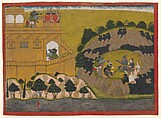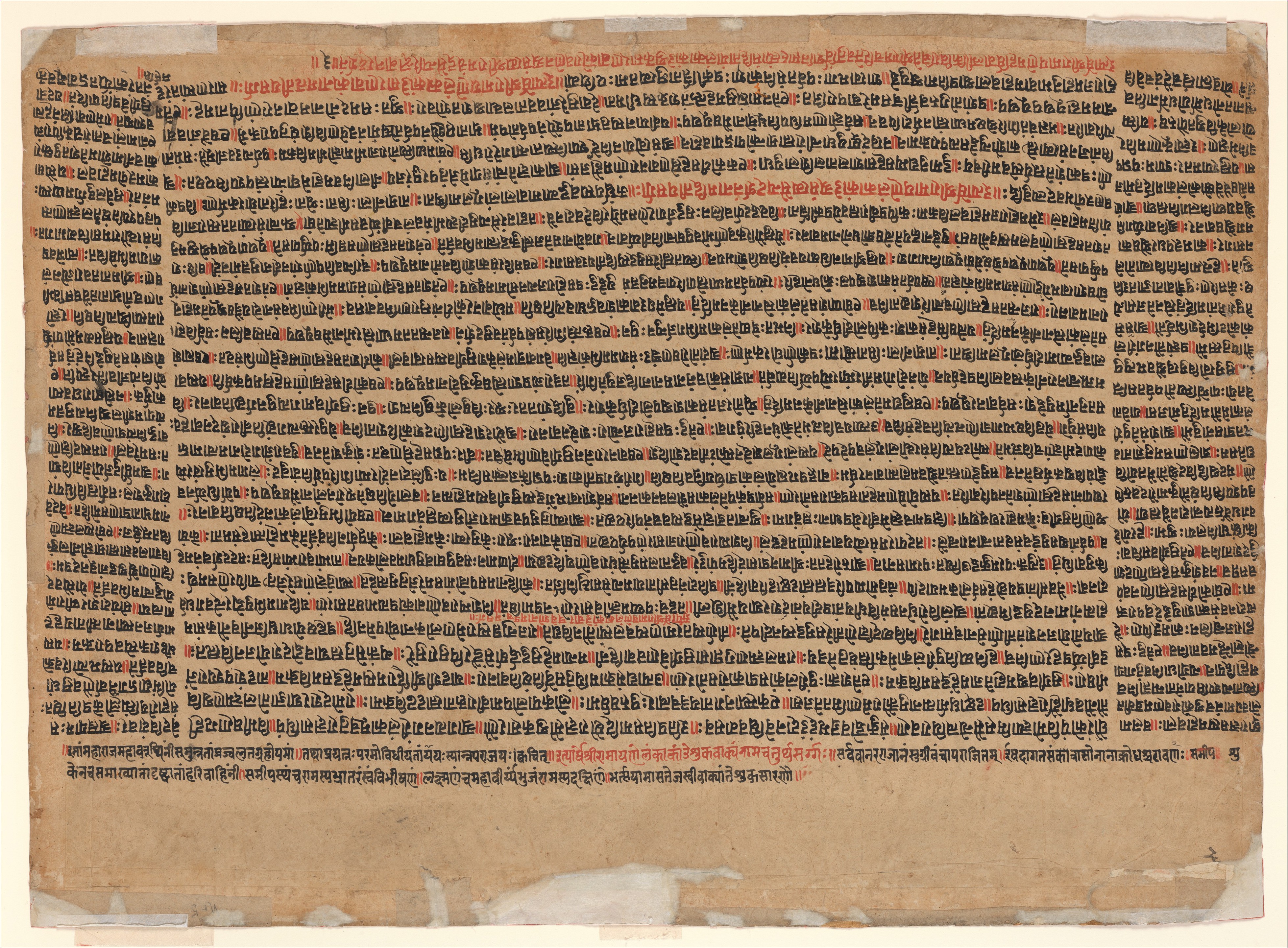Rama Releases the Demon Spies Shuka and Sarana: Folio from the Siege of Lanka series
Attributed to Manaku Indian
Not on view
On the eve of the great battle, Ravana sent the spies Shuka and Sarana to assess the strength of Rama's monkey and bear armies. Vibhishana discovered the spies, arrested them, and brought them before Rama (at right). Rama, sitting with Lakshmana and Sugriva, set them free, as they had come as "envoys" and were not armed. The demon spies are seen entering the palace and, at the top, reporting to Ravana. They tell of the terrifying strength of Rama's generals and his invincible army: "Vibishana took us captive with the intention of slaying us, O king, but Rama, he whose valor is immeasurable, seeing us, let us go."
This painting is from an important commission, only a few folios of which were finished. The artist, Manaku, used a continuous narrative, sequencing the three events. That, in turn, shaped the composition, which juxtaposes Ravana's golden fortress with Rama's encampment, encircled by monkey and bear warriors. It contrasts flat planes of color, characteristic of earlier Basohli styles, with more naturalistic elements that were becoming the trademark of the Guler-Kangra style.
About the Artist
Manaku
Active at the court in Guler ca. 1725–ca. 1760; son of Pandit Seu, brother of Nainsukh, father of two sons, Fattu and Khushala
The painter Pandit Seu worked in Guler, Himachal Pradesh, and together with his two sons Manaku and Nainsukh, he dominated one of the most exciting periods of Pahari painting. Manaku remained more indebted to his father’s style, while Nainsukh studied Mughal painting extensively and left the court in Guler to work for other patrons. Manaku, the older of the two brothers, produced a true masterpiece in 1725, his illustrations to the last part of the Ramayana, the so-called Siege of Lanka series. In that work, he continued the large-format Ramayana series that his father had begun, developing new compositional solutions for the depiction of complex narrative scenes. The young Manaku painted with the sure hand of a seasoned practitioner, and his talent, attested by his drawings, was immediately celebrated. Around 1730, he produced a series of 150 folios on one of the central texts of Krishna worship, the Gita Govinda. No illustrations for that text had been painted before in the Pahari region. Created for a Lady Malini, the series represents the crucial turning point in Manaku’s early work. It presented a considerable challenge to understand all the subtleties and complexities of the text and to develop appropriate compositional solutions. An especially beautiful example is Manaku’s visualization of the textual passage describing the south wind cooling itself in the Himalayas.
Manaku’s work borrowed from that of his father, Pandit Seu, in its formal repertoire, especially visible in conventions for rendering trees and faces and in its compositions with monochrome backgrounds and high horizon lines with white and blue washes. Only in his later works did more realistically painted elements become more evident.
The artistic legacy of the brothers Manaku and Nainsukh was taken up by their sons. A series attributed to Manaku’s son Fattu, from around 1760, reveals considerable borrowing from Manaku’s work, while the style of other known works by the sons of these brother artists is more reminiscent of that of Nainsukh.
Due to rights restrictions, this image cannot be enlarged, viewed at full screen, or downloaded.
This artwork is meant to be viewed from right to left. Scroll left to view more.




